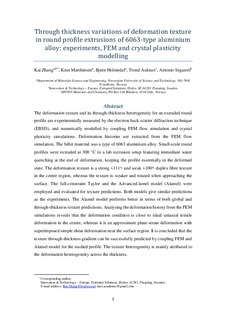| dc.contributor.author | Zhang, Kai | |
| dc.contributor.author | Marthinsen, Knut | |
| dc.contributor.author | Holmedal, Bjørn | |
| dc.contributor.author | Aukrust, Trond | |
| dc.contributor.author | Segatori, Antonio | |
| dc.date.accessioned | 2018-12-12T09:11:56Z | |
| dc.date.available | 2018-12-12T09:11:56Z | |
| dc.date.created | 2018-06-27T15:05:46Z | |
| dc.date.issued | 2018 | |
| dc.identifier.citation | Materials Science & Engineering: A. 2018, 722 20-29. | nb_NO |
| dc.identifier.issn | 0921-5093 | |
| dc.identifier.uri | http://hdl.handle.net/11250/2577296 | |
| dc.description.abstract | The deformation texture and its through-thickness heterogeneity for an extruded round profile are experimentally measured by the electron back-scatter diffraction technique (EBSD), and numerically modelled by coupling FEM flow simulation and crystal plasticity simulations. Deformation histories are extracted from the FEM flow simulation. The billet material was a type of 6063 aluminium alloy. Small-scale round profiles were extruded at 300 °C in a lab extrusion setup featuring immediate water quenching at the end of deformation, keeping the profile essentially in the deformed state. The deformation texture is a strong <111> and weak <100> duplex fibre texture in the centre region, whereas the texture is weaker and rotated when approaching the surface. The full-constraint Taylor and the Advanced-lamel model (Alamel) were employed and evaluated for texture predictions. Both models give similar predictions as the experiments. The Alamel model performs better in terms of both global and through-thickness texture predictions. Analysing the deformation history from the FEM simulations reveals that the deformation condition is close to ideal uniaxial tensile deformation in the centre, whereas it is an approximate plane-strain deformation with superimposed simple shear deformation near the surface region. It is concluded that the texture through-thickness gradient can be successfully predicted by coupling FEM and Alamel model for the studied profile. The texture heterogeneity is mainly attributed to the deformation heterogeneity across the thickness. | nb_NO |
| dc.language.iso | eng | nb_NO |
| dc.publisher | Elsevier | nb_NO |
| dc.rights | Attribution-NonCommercial-NoDerivatives 4.0 Internasjonal | * |
| dc.rights.uri | http://creativecommons.org/licenses/by-nc-nd/4.0/deed.no | * |
| dc.title | Through thickness variations of deformation texture in round profile extrusions of 6063-type aluminium alloy: Experiments, FEM and crystal plasticity modelling | nb_NO |
| dc.type | Journal article | nb_NO |
| dc.type | Peer reviewed | nb_NO |
| dc.description.version | acceptedVersion | nb_NO |
| dc.source.pagenumber | 20-29 | nb_NO |
| dc.source.volume | 722 | nb_NO |
| dc.source.journal | Materials Science & Engineering: A | nb_NO |
| dc.identifier.doi | 10.1016/j.msea.2018.02.081 | |
| dc.identifier.cristin | 1594256 | |
| dc.description.localcode | © 2018. This is the authors’ accepted and refereed manuscript to the article. Locked until 22.2.2020 due to copyright restrictions. This manuscript version is made available under the CC-BY-NC-ND 4.0 license http://creativecommons.org/licenses/by-nc-nd/4.0/ | nb_NO |
| cristin.unitcode | 194,66,35,0 | |
| cristin.unitname | Institutt for materialteknologi | |
| cristin.ispublished | true | |
| cristin.fulltext | postprint | |
| cristin.qualitycode | 2 | |

